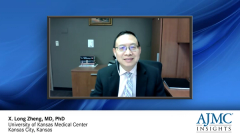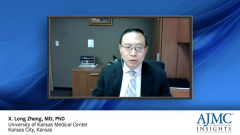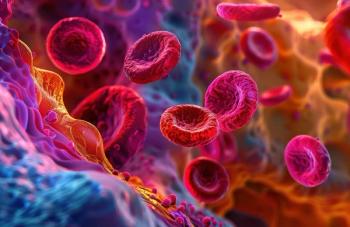
Treatment Considerations for Caplacizumab
X. Long Zheng, MD, PhD, explains when physicians should administer caplacizumab after suspecting a diagnosis of acquired TTP, and discusses the risk of relapse or refractory disease.
X. Long Zheng, MD, PhD: The question is, should you give caplacizumab up front when you have a diagnosis of TTP [thrombotic thrombocytopenic purpura]? Or do you want to wait until this patient has recurrent disease, or is not responding to plasma exchange? Based on ISTH [International Society on Thrombosis and Haemostasis] guidelines, and all the panelists agree, giving caplacizumab is better than not giving caplacizumab. The reason is that despite the daily plasma exchange, we may not be able to neutralize all the antibodies against ADAMTS13 and elevate ADAMTS13 to a threshold at which the patient is not going to have thrombosis. The earlier you can stop thrombosis, the better for your organs to recover. This brings up whether we should give caplacizumab as early as possible. ISTH guidelines suggest we should give caplacizumab as early as possible, even on the first or second day if you can. That being said, you definitely need to have caplacizumab available in your hospital. You can’t wait for somebody to ship it to you, which could take 2 or 3 days, where you lose the golden opportunity to stop thrombus formation.
Do you need an ADAMTS13 [result] to confirm the diagnosis of acquired TTP before you give caplacizumab, or should you give caplacizumab and then wait for the ADAMTS13 result to decide whether you should continue or stop? According to the ISTH guidelines, as long as you have a high suspicion of TTP—let’s say, either a PLASMIC score of greater than 6, or a French score usually of 2 points—these patients are at a high probability of having ADAMTS13-deficient TTP. In this case you start a plasma exchange right away. You should also get caplacizumab on board as soon as possible, not waiting for ADAMTS13 to come back. At the same time, you should give corticosteroids and rituximab. If you were going to send out an ADAMTS13 test, you send it out before you do a plasma exchange. When the ADAMTS13 test comes back, [a result of] less than 10% confirms this is acquired TTP, then everything you put the patient on will continue. So, plasma exchange, rituximab, caplacizumab, and corticosteroids. If the ADAMTS13 comes back greater than 20%, you have to go back and look at that patient. You could consider stopping their treatment because even though the clinical symptoms look like TTP, this patient may not have TTP at all. If the patient’s ADAMST13 comes back between 10% and 20%, then the decision is yours. You have to base [the decision] on your patients for whether you should continue caplacizumab, plasma exchange, or any other treatment. It’s up to you to decide that.
What’s the rate of exacerbation and relapse in acquired TTP after you’re giving this treatment? Before caplacizumab was approved for treatment, we have done a study, and many other groups have also done studies that show that nearly 50% of patients, despite a daily plasma exchange, had an exacerbation during treatment. The platelets rise for a couple of days, and then fall for another couple of days, up and down, up and down, like a stock. Since the introduction of caplacizumab, very rarely will a patient have an exacerbation. It’s almost eliminated. In terms of relapse, that depends on whether the patients continue producing antibodies against ADAMTS13, and when that antibody will come back. As you know, all the treatments right now are targeted at trying to eliminate the B cells that are not making antibodies, but just eliminating B cells may not be sufficient in some cases. The plasma cells that are living in the tissue cannot be killed with rituximab. Therefore, once you stop all this treatment, some patients are still going to relapse. There are still about 30% to 50% of patients who will experience at least 1 to 2 relapses during the next 10 years. The chance of relapse is still there no matter what treatment we have given them. But exacerbation can be almost abolished by the introduction of caplacizumab.
Transcript edited for clarity.
Newsletter
Stay ahead of policy, cost, and value—subscribe to AJMC for expert insights at the intersection of clinical care and health economics.

































































